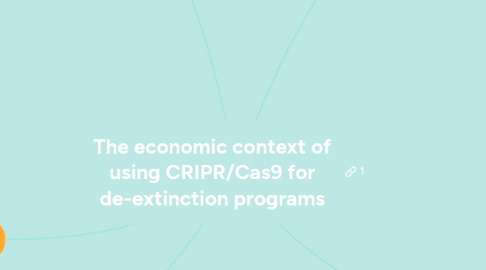
1. How applicable the technology would be for them
1.1. Careful thought would be required about what species to introduce and where because the climate may have changed dramatically since they were alive
2. Scientists
2.1. Perspectives:
2.1.1. Scientist would be interested and motivated to explore how this technology could benefit conservation efforts without endangering current eco-systems however they would be reliant on convincing funding bodies on the value of their work for the world in general
2.2. Potential outcomes for this stakeholder- positive and negative:
2.2.1. Positive- De extinction could be useful for inspiring new science
2.2.2. Negative- By bringing back extinct species could negatively impact the environment by potentially making more species extinct
2.3. Arguments they would use to support their decisions:
2.3.1. By bring back extinct species could have the potential to prevent more species from becoming extinct
3. Philanthropists
3.1. Perspectives:
3.1.1. De-extinction could be beneficial for most conservation and commercial gain
3.2. They invest in something that could benefit the world and change the dynamic of the ecosystems for the better
3.3. Potential outcomes for this stakeholder- positive and negative:
3.3.1. There donations could go to waste
3.3.2. They could invest in something that negatively impacts them
3.4. Arguments they would use to support their decisions:
3.4.1. By bringing back extinct organisms could potentially improve the dynamic of the ecosystems
4. Government
4.1. Perspectives:
4.1.1. The government has one bucket of money to fund conservation and they need to invest this in the programs and initiates that yield the greatest benefit. They would need to conduct a rigorous cost benefit analysis before investing money in CRISPR technology for de-extinction.
4.2. Potential outcomes for this stakeholder- positive and negative:
4.2.1. Further stretching already strained conservation budgets to cover the costs of de-extinction could endanger current species
4.2.2. Positive- By providing funding towards bringing back extinct species could mean saving more species from going extinct meaning less funding would go into preventing extinction
4.3. Arguments they would use to support their decisions:
4.3.1. CON: Australian research has shown that the benefits of bringing back one lost species would cost the extinction of significantly more endangered species
4.3.2. Initial cost to resurrect an extinct species is unknown
4.3.3. In general it may be best if we focus of the many species that need our help at the moment
4.4. In addition to the cost of resurrecting is the expense required to reintroduce the species into the wild and to protect them
4.5. How applicable the technology would be for them
5. The general public
5.1. Perspectives:
5.1.1. The general publics perspective will be quiet varied depending on their personal views and perspectives on conservation and climate change.
5.2. Potential outcomes for this stakeholder- positive and negative:
5.2.1. Negative: Bringing back extinct species could lead to biodiversity loss rather then gain
5.2.2. Negative: Potential for millions of tax payer dollars to be wasted if programs were unsuccessful that could have been used more benificially
5.2.3. Positive: potential for a successful outcome that may benefit conservation efforts
5.3. Arguments:
5.3.1. PRO: The species might be culturally or symbolically important and so the financial implications would be considered worth while
5.3.2. CON: No one has yet been able to revive an extinct species so is it really possible?
